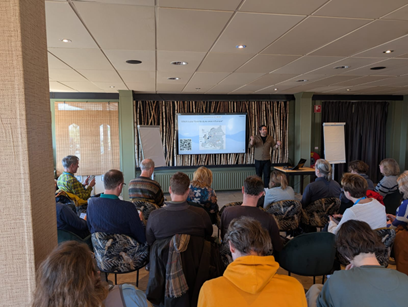Written by Filipe Galiforni Silva (TUDelft).
Nowadays, nature-based solutions such as hybrid dune-dike systems are an integral part of several coastal management and protection plans. Understanding and managing these interventions in dynamic coastal systems requires tools to predict system behavior in a range of conditions and time-space scales. In recent years, Predictive Digital Twins (PDT) emerged as a potential tool that uses process-based and data-driven models to predict system behavior based on near real-time data integration, providing stakeholders with insights into the system’s behavior and reliability. In the context of coastal dunes and beach systems, the PDT brings together physics-based models, data assimilation, and decision-making tools to help us anticipate how coastlines might evolve at different time-space scales.
Why do we need this in coastal sciences?
Traditional monitoring and modeling approaches are often confined to specific time-space scales, limiting their usefulness for integrated coastal zone management. The PDT bridges this gap by continuously combining observations and numerical models to provide a coherent, up-to-date state of the system. This enables researchers, policymakers, and coastal managers to directly assess the effects of different interventions, such as nourishment or dune reinforcement, or different hybrid designs, before they are implemented at a range of time-space scales without the need to set separate models or tools. By simulating both natural processes (like storms, waves, and sediment transport) and human interventions, the PDT helps us test hypotheses, reduce uncertainty, and design more resilient coastal systems.
End-user focus: from concept to practice
A key part of developing the PDT is ensuring that it fits the needs of its end users. This involves regular interaction with stakeholders, including water boards, municipalities, and nature conservation agencies, to co-develop use cases and interfaces that are both technically sound and practically useful. Thus, we have been actively engaging with stakeholders in workshops to not only demonstrate our tool but also to receive direct feedback from one of the main prospective users (Figure 1). Whether it is identifying when and where to intervene after a storm or evaluating long-term strategies under different climate scenarios, the PDT aims to add value to the decision-support process of nature-based solutions in coastal systems.
Next steps
The development of the PDT is still ongoing, but with positive prospects. We are currently integrating new model couplings and working on our web-based graphical interface for our first medium-scale prototype. In the coming years, the goal is to make the PDT modular and transferable, so it can be adapted to different hybrid dune-dike systems. Ultimately, the PDT is a collaborative framework that brings together science, technology, and practice to support smarter, more adaptive coastal management.

Figure 1: Workshop done in collaboration with the MANABAS consortium to get feedback and align user needs with the proof-of-concept.
---------------------------------------------------------------------------------------------------------------------------------------------------